Reading my past article on Beneteau´s “blue offensive” about the new Oceanis 30.1e as displayed in recent Paris Boat Show you might have got the first impression on what is happening right now. I promised to take you much deeper into this topic which, I promise, is beyond greenwashing PR but instead a full-fledged shift of paradigms. This is so heavyweight because Groupe Beneteau is the market leader. Up until now it were just smaller companies or smaller projects within companies, now, this is different: Beneteau has set a course for all of its brands towards serious sustainability in boatbuilding.
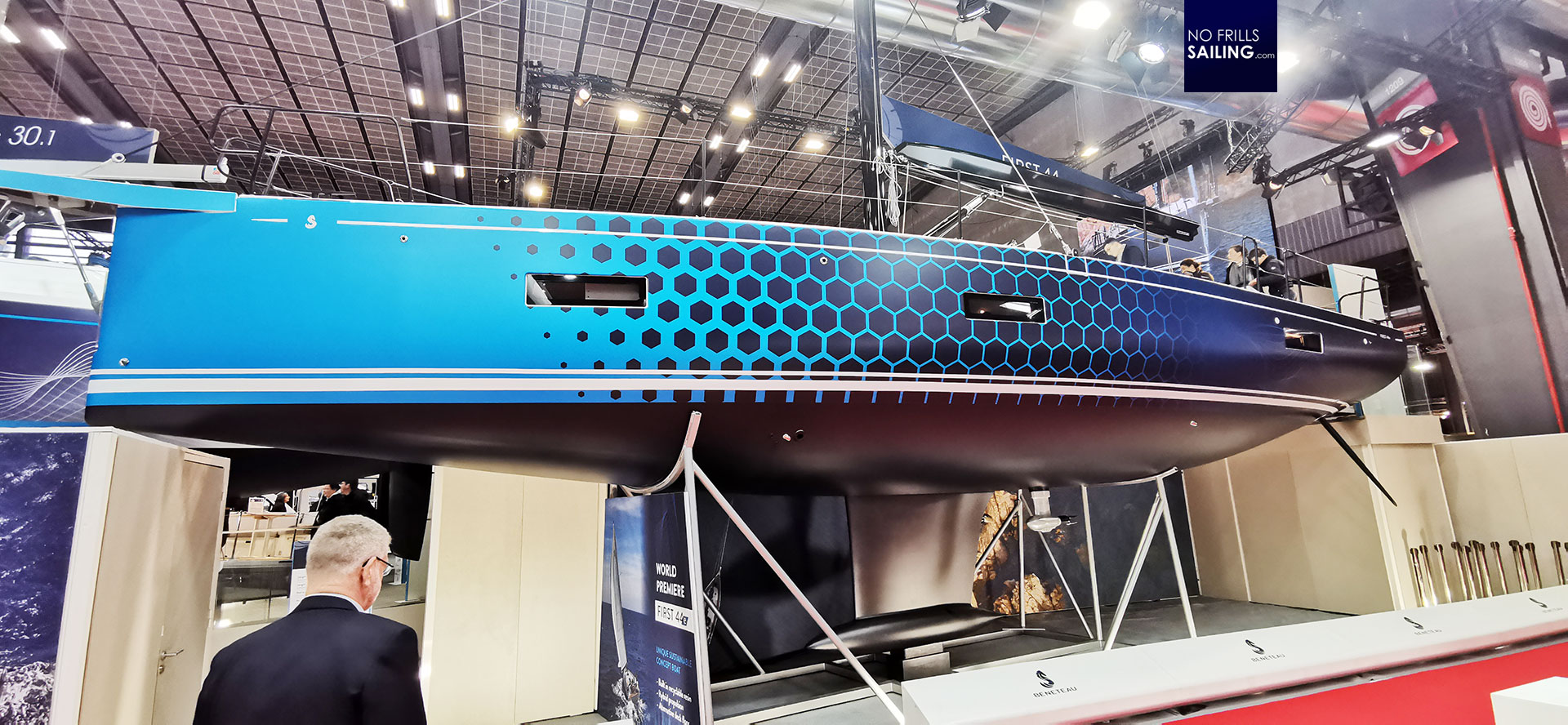
In Paris they showcased the Oceanis 30.1e which is a full-electric sailboat offered for skipper who are sailing in CE Category C areas, which is basically lakes. 12 miles range seems not as impressive, but given the fact that normally you only need an engine to cast off and berth the boat, it should be sufficient. Also, combined with a solar array this could mean a fully self-sustainable energy management. Recuperation is possible, but the effect is vastly exaggerated, negligible. Next to the Oceanis 30.1 another yacht was on display: The First 44e. In this, Beneteau takes it one step further, or shall I say, several steps?
Twin pod electric propulsion
At first, the attentive visitor, upon entering the stand, may have noticed an unusual arrangement saildrives. It´s plural since the First 44e has two of them. In fact, these are Torqeedo Cruise 12.0 pod drives, electric of course. The drives are positioned extremely forward compared to traditional saildrive or shaft positions, just behind the keel, which is the pivoting point of the hull for sideways motions. This setup seems rather unusual but has its advantages.
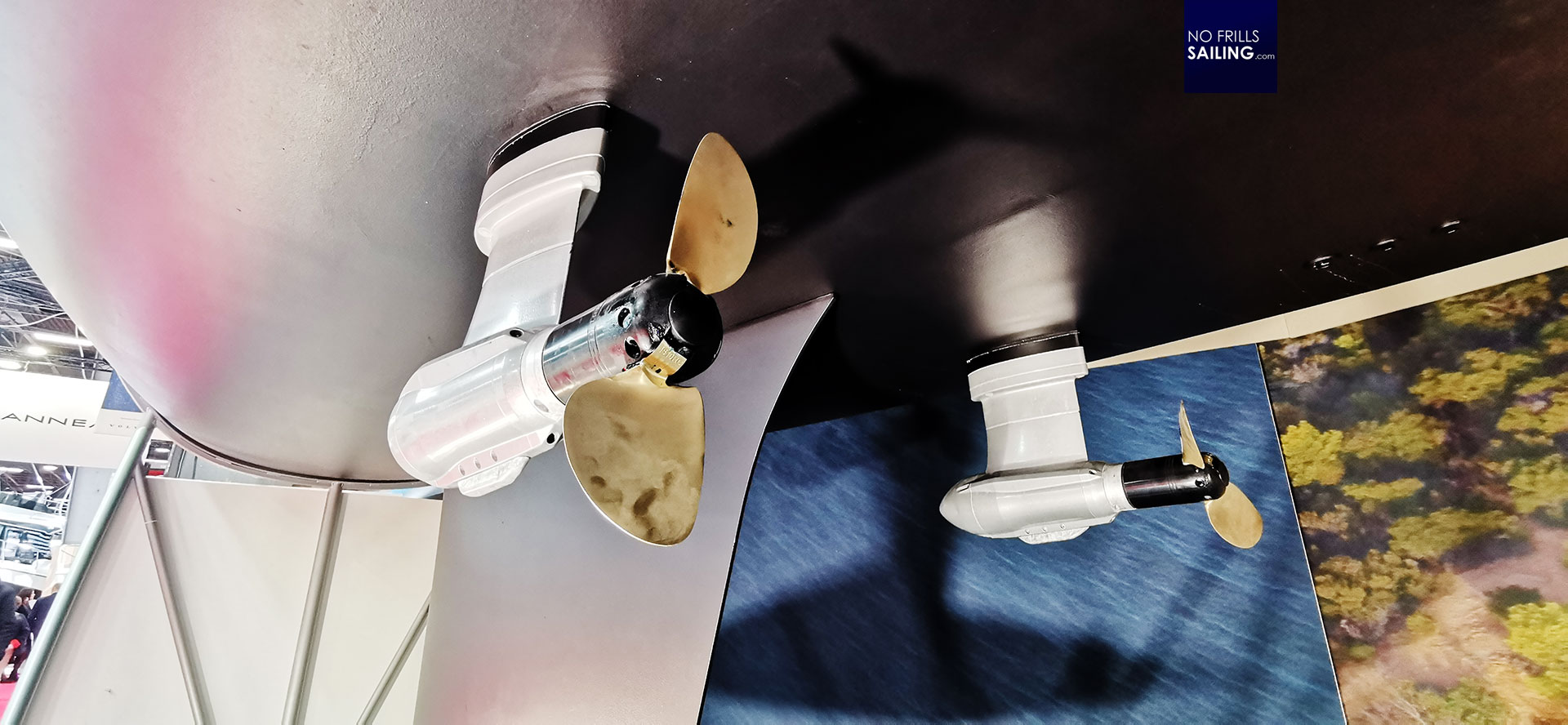
First of all, apart from the fact that those two screws create a vortex that is directed onto the twin rudder blades, it shall negate one of the often talked about disadvantages of having twin rudder configurations versus single rudder. Secondly, and most important, the boat does not need a bow thruster, as Damien Jacob of Beneteau assures me, and may be steered just like a catamaran when maneuvering. This could be interesting …
Torqeedo battery power house
Going inside and looking underneath the floor boards, of which the trade show team wisely removed two and put on walk-on plexi instead so that we can see what´s underneath, it´s the big boy WH 48-5000 Lithium batteries by Torqeedo again. The new First 44e will have four of them in total. Those batteries power the whole ship. As I understood this, the capacity is more than sufficient to run engine and electric equipment out of those 4 x 5 kilowatts stores.

The batteries, according to Damien Jacob, deliver enough electric current. Most of the customers of Beneteau (and I can personally confirm) will use their boats for occasional weekend sailing or even daysailing, returning to home berth in the afternoons. Much less than we always think will take their boats on long haul trips or even ocean crossings, circumnavigations. In this, daily replenishing of the batteries is in the majority of use cases given.
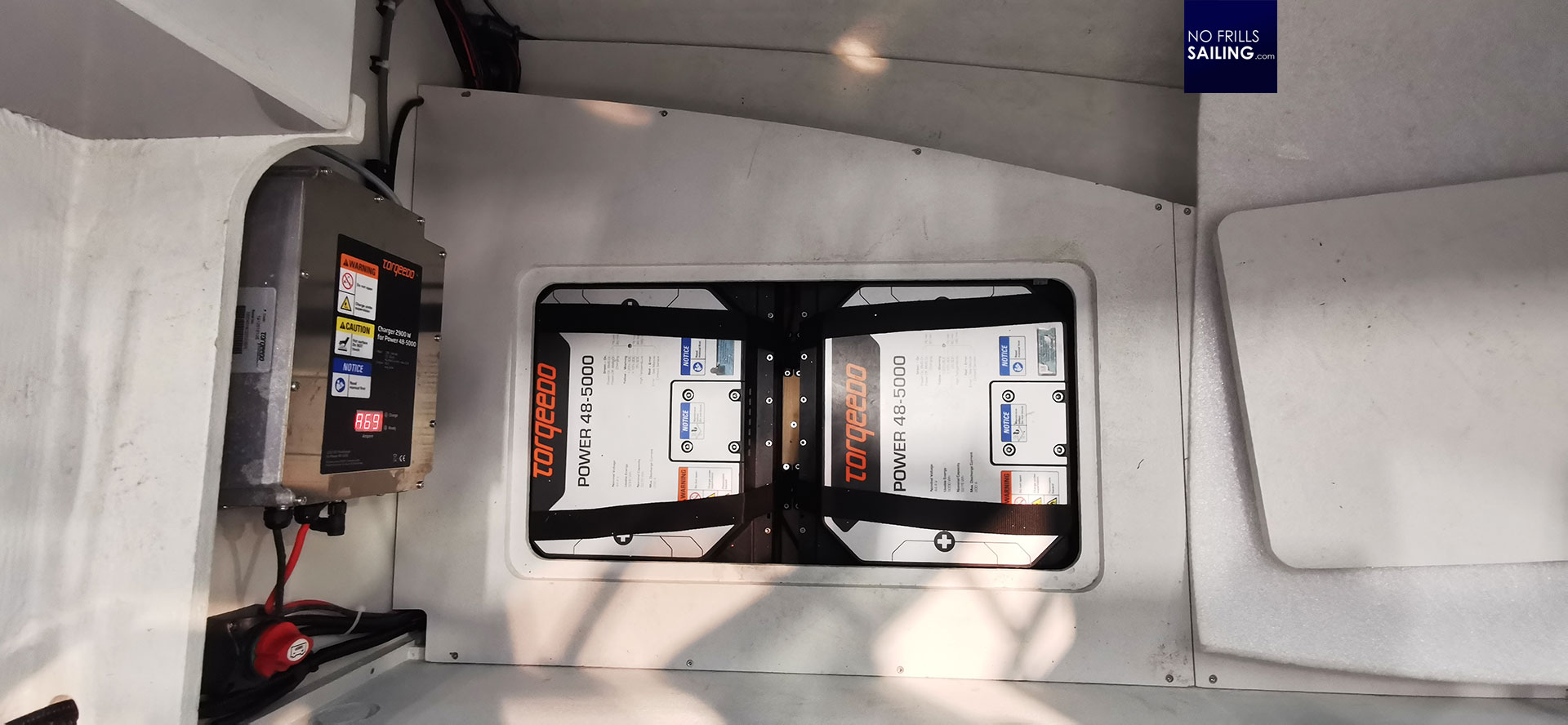
Just as with the Oceanis 30.1 the First 44e will indeed have no Diesel fuel tank, no Diesel engine of course and no auxiliary equipment. Of course, “electric sailing” is vastly different from traditional sailing as the skipper needs to develop new strategies when under engine, I will dive deeper into this in following articles. Let´s return to the First 44e for now.
Hybrid sailing for offshore usage
Other than the Oceanis 30.1 where the engine room is left absolutely empty, the First 44e features a generator. It´s a 13.5 Kilowatts Fischer-Panda genset that makes the 44e a hybrid sailing boat. Now whwre´s the logic here? Some may say that a traditional sailboat has already its powerhouse in form of an Diesel engine. This is capable to generate electric power and reload batteries as well. This is true but a Diesel engine run at low throttle is vastly inefficient compared to a smaller Diesel-engine that is running at optimum throttle and made to generate electric current through its alternator.

I am currently trying to gain some valid data like fuel consumption per hour of an ordinary Diesel loading batteries versus generator loading batteries. As people tell me, consumption is considerably lower for the latter. So is noise generation and general comfort level aboard which will be much better under “engine”, which on the First 44e will be “loading” than having the big Diesel running. Also, looking at both the “engine rooms” of First 44e and most of all the vast void underneath Ocanis 30.1e´s cockpit, I am sure that in second generation “blue” sailing yachts the designers will come up with solutions of how to use this new volume for the crew. More stowage, bigger aft cabins … there are so many possibilities.
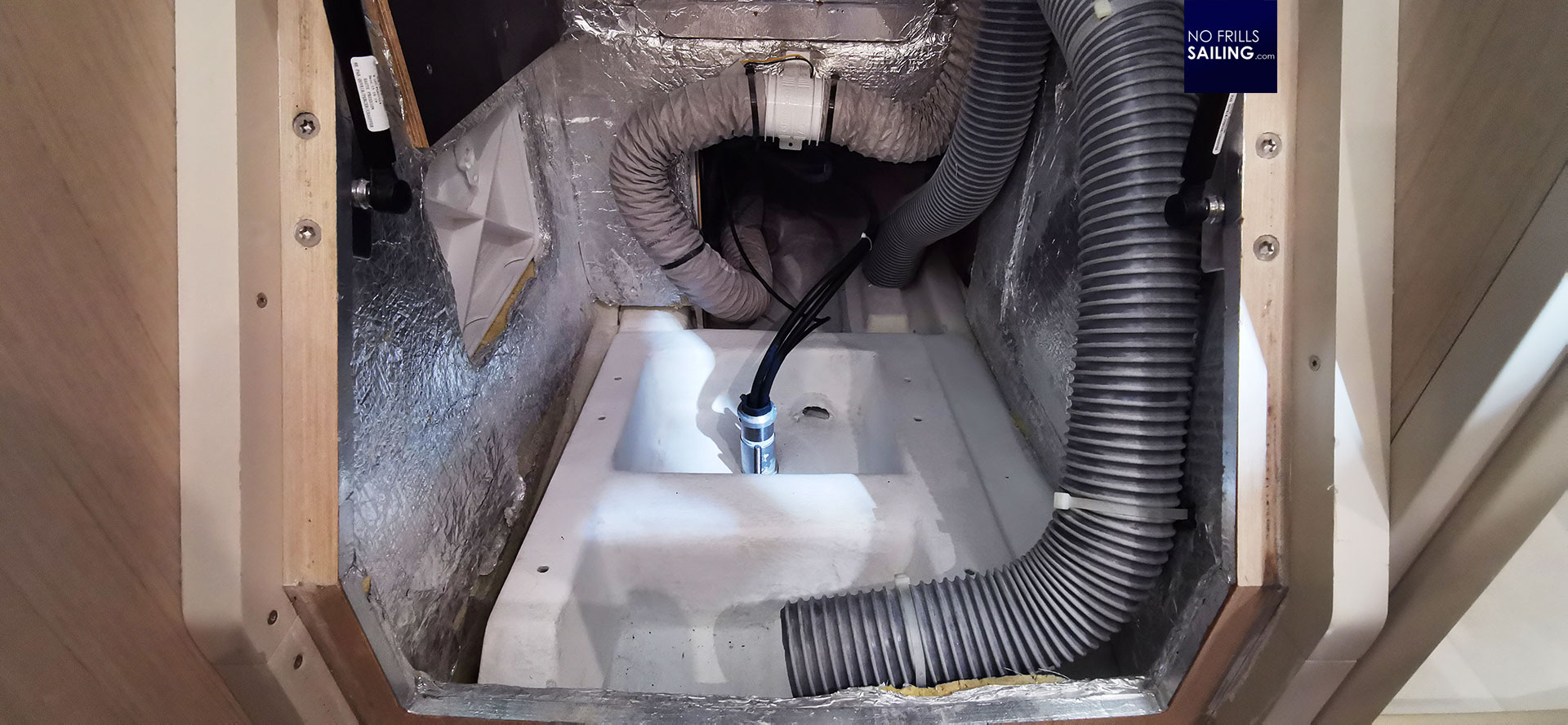
So, how is it range-wise for the First 44e then, you may ask. This (type of) boat has never seen water as the prototype straight went to Paris Boat Show and is now being transported to Diesseldorf where it is showcased end of January during BOOT. Afterwards, she will be used for extensive sea trials. But, as Damien Jacob tells me, Beneteau is not looking for range. The boat will have a projected running time of nearly 3 hours in full-electric propulsion mode with a sped of 5.5 knots. Seems sufficient for casting off and berthing. For longer trips, the generator may provide replenishment for the Lithiums.
Collaboration with Arkema: Elium recyclable resin
I´ve said that the First 44e is several steps up the ladder, apart from being hybrid-powered. Looking at the boat from the outside, one does not see a significant difference, more over because of the nice stickers applied. But this is in fact a major step forward in terms of sustainable boat building: For the first time a big brand company now offers a production boat made with a recyclable hull. And this indeed is huge!
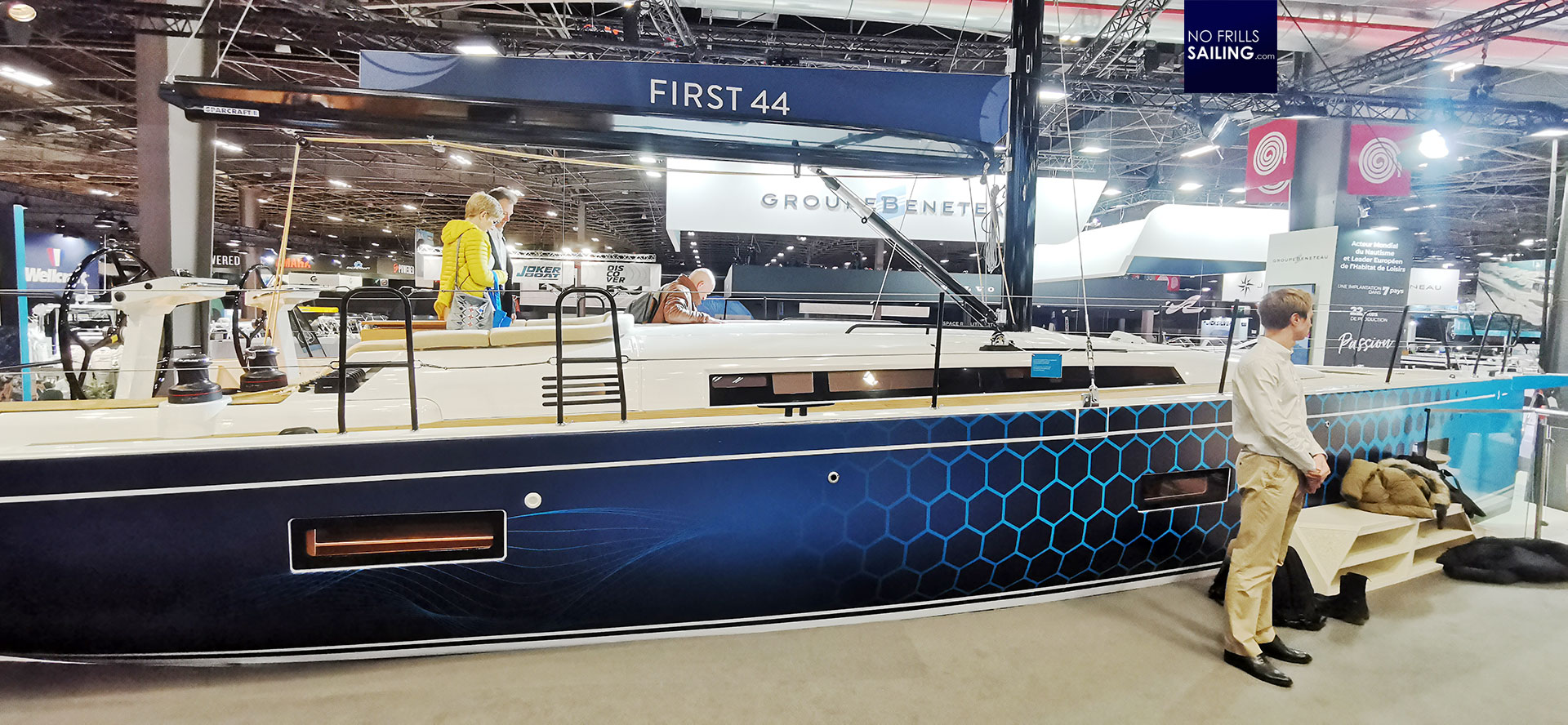
I can tell you that for the time I run this magazine, which is the fifths years now, I desperately tried to make an article about “where do all the old boats go?”. This is a big thing. GRP hulls cannot be recycle. There is no way to separate resin and glass fibres. Usually, the boats will be emptied of (hopefully) all non-plastic materials, they will be shreddered to little pieces and then burned. Burned like ordinary garbage. At least they provide heat by that, but it is a huge waste of precious resources: In the end, our dream yachts are made of crude oil. So, that is why offering a production boat hull with a recyclable hull is big time news.

French company Arkema, which funny enough I “know” from my catamaran adventure last year when I was kind of boxed in between the ARKEMA class fifty racing catamaran. They developed a resin called “Elium” which is fully recyclable. I could not fully research the process of recycling (which I will, promised!) but I supposed the hull, at the end of its life, will be treated with heat so that resin and fibres separate and can be re-used, at least the resin. This is tons and tons of re-usable precious stuff rather than tons of tons of it being irrecoverably burned away.
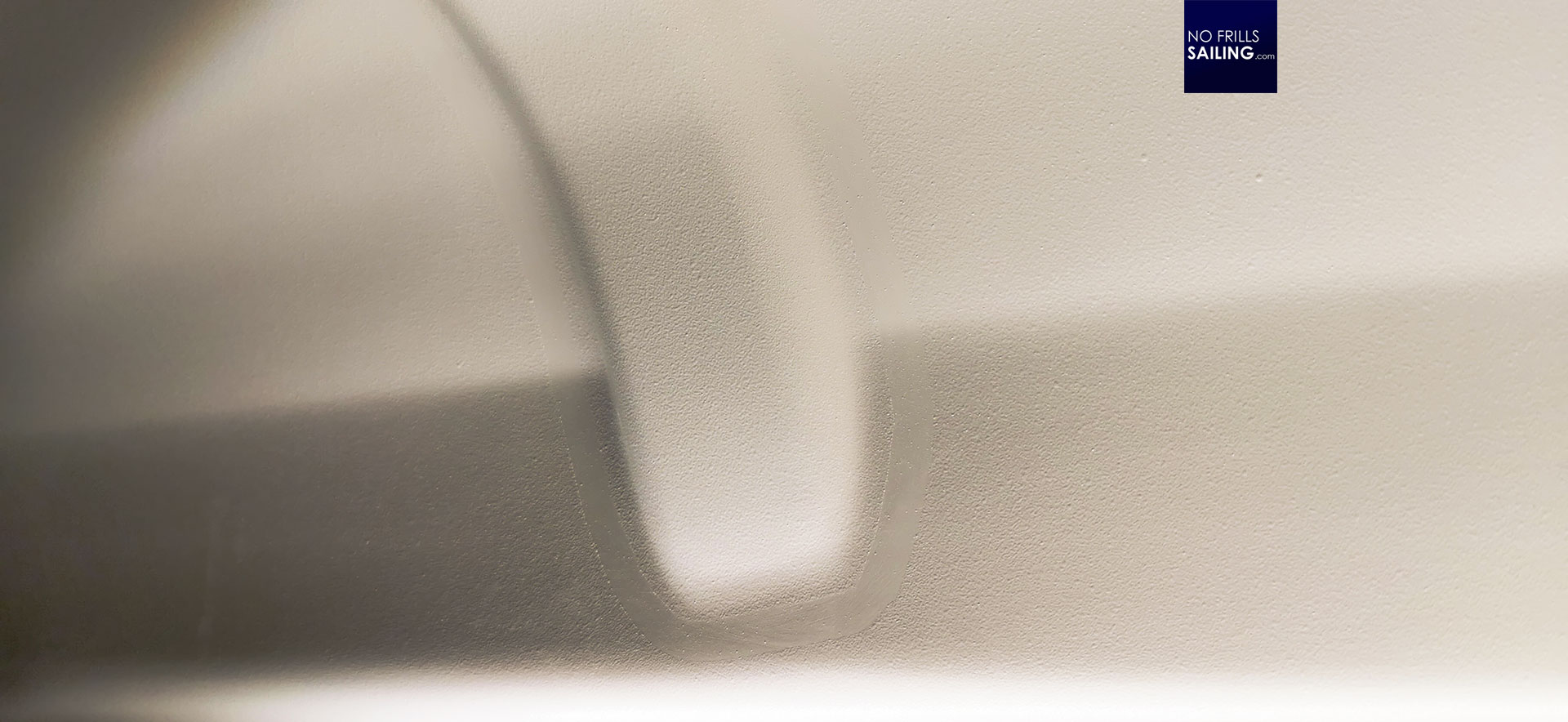
Inside the boat, doing the knocking and strolling of the GRP-parts, I notice nothing unusual. The boat (brand new!) smells like they usually do and the knocking sounds do not reveal anything else than the good old plastic sounds. Damien Jacob say that Elium-infused laminate has the same material properties in terms of strength, flexibility and – most of all – weight than polyester. There is no different whatsoever. Well, at least material-wise. But let´s keep the budget-discussion down for now.
A gradual substitution of crude oil products
Apart from being an electric-hybrid boat built with a recyclable hull, the First 44e bears some more details worth noticing. I take a picture of a small showcase of raw material usage within Beneteau. It´s a bundle of hemp fibres which, next to it, is arranged to a woven mat. Damien Jacob tells me that Beneteau already substituted glassfibre mats with hemp-garments in all of the small arts in their boats. I find this remarkable. This step is already taken and in all of their boats hatches, flaps, covers and all sorts of smaller components which do not have to be structurally valid for the whole are made with hemp.

Just considering a boat like the First 44 how many of those smaller parts are now free of glassfibers? The use of biosourced materials is a top priority in Beneteau´s R&D efforts. Hemp is known for, I´d say, centuries to be a strong, reliable and easy to use fiber. Apart from the ongoing discussion of a revival of THC in medicine, the fibers in clothing and – like now – industrial usage is a huge step forward. Next to the bundle-showcase is a ready laminated piece of “hemp-plastic” and it feels like any other plastic-laminate.
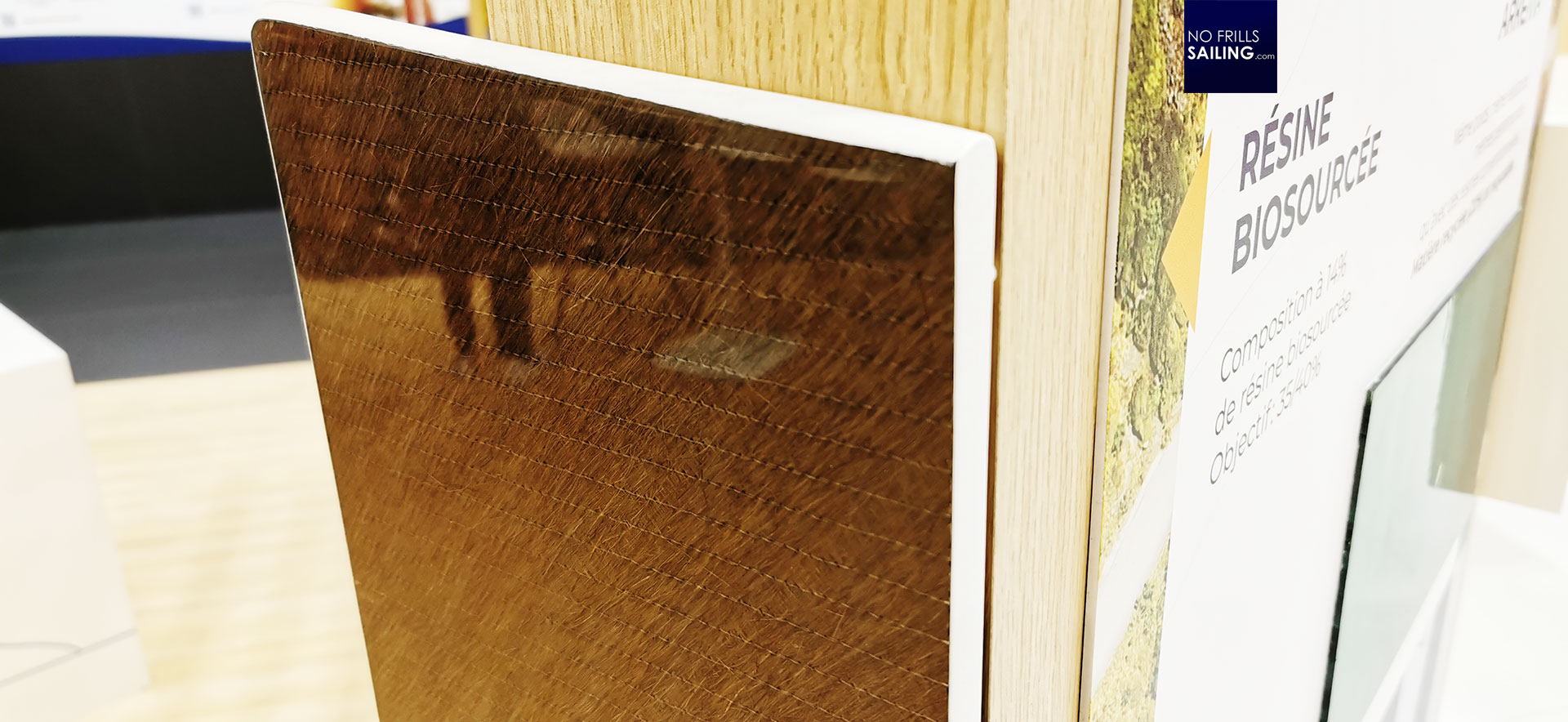
Here are just some numbers: Damien Jacob tells me that just at Beneteau they are speaking of making some 30.000 parts per year which fall under this definition. Substituting hemp and also partially biosourced resing for these parts sums up to the equivalent in weight to some 200 boats! I find this highly remarkable. Some other yards are communicating here and there about their one single “green” boat built like that but here we have a company doing the equivalent to 200. And it already started. A major shift in GRP-production boat building.
Another alternative for Teak
And it doesn´t stop there. There´s even more. I´ve recently wrote some articles about supplanting Teak in boatbuilding, most of it rooted in sanctions against the military government of Myanmar. There are several ways to go, some use Cork, some other plastic substitutions (which isn´t a really sustainable path I´d say) but here is Beneteau´s solution: Iroko.

Iroko is just the commercial brand name, the tree is called Milicia. It´s a huge tree predominantly growing in tropical regions of Africa. Thatswhy some also call it “African Teak”. It has similar properties like Teak and is widely used for furniture and alike. Some trials have ben made in the past to use Iroko as a decking material for boats but it never really had it´s breakthrough. I know that back in the day Bavaria had introduced Iroko-decks but abstained from it because of huge quality issues.
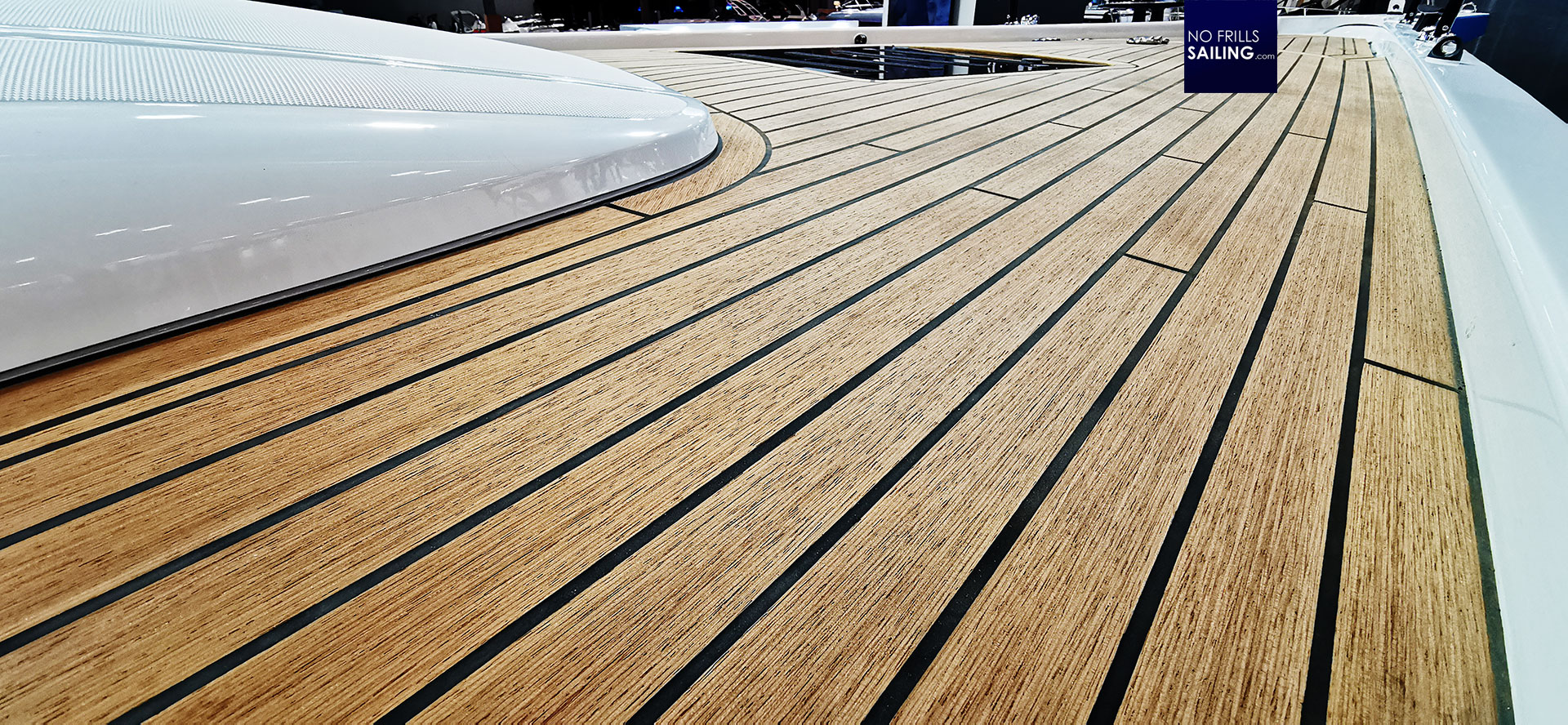
With Beneteau it will be different: The decking produced for the First 44e (and probably other boats as well) won´t consist of massive wooden battens. The raw timber will be processed. As Damien tells me, it is a similar process as Alpi uses it to cut up and re-arrange birchwood to mimic every other timber. With the new Iroko-deckings Beneteau may be able to offer real wood alternative and I must say, it looks, smells and feels nearly indistinguishable from Teak. If this is environmentally sound, switching from Far Eastern timber to African timber, well, it remains to be proven. I will certainly dive deeper into the Iroko-topic in following articles.
Definitely not a greenwashing PR-stunt
All this, electrification, biosourcing and bio-supplementation, new resins, hemp-fibers and further pushing Research & Development to come up with new solutions is not a marketing strategy. In fact, Beneteau puts themselves in the crosshairs: An Oceanis 30.1e is currently 5.800 Euros more expensive than the standard Diesel-powered boat. That´s a plus of 6 percent. Not too much, I´d say. The First 44e-version is not priced yet but it will clock in as well, although unconfirmed it is rumored that Elium-resin is roughly a third more expensive than polyester. But, is there any other way? Damien Jacob says, that this is not just a “trend” anymore. Politics, public demand and good governance demand to seriously change habits, change the way to produce. “You can´t stop it. Somebody has to do it. And we are determined to go on being pioneers on that path.”
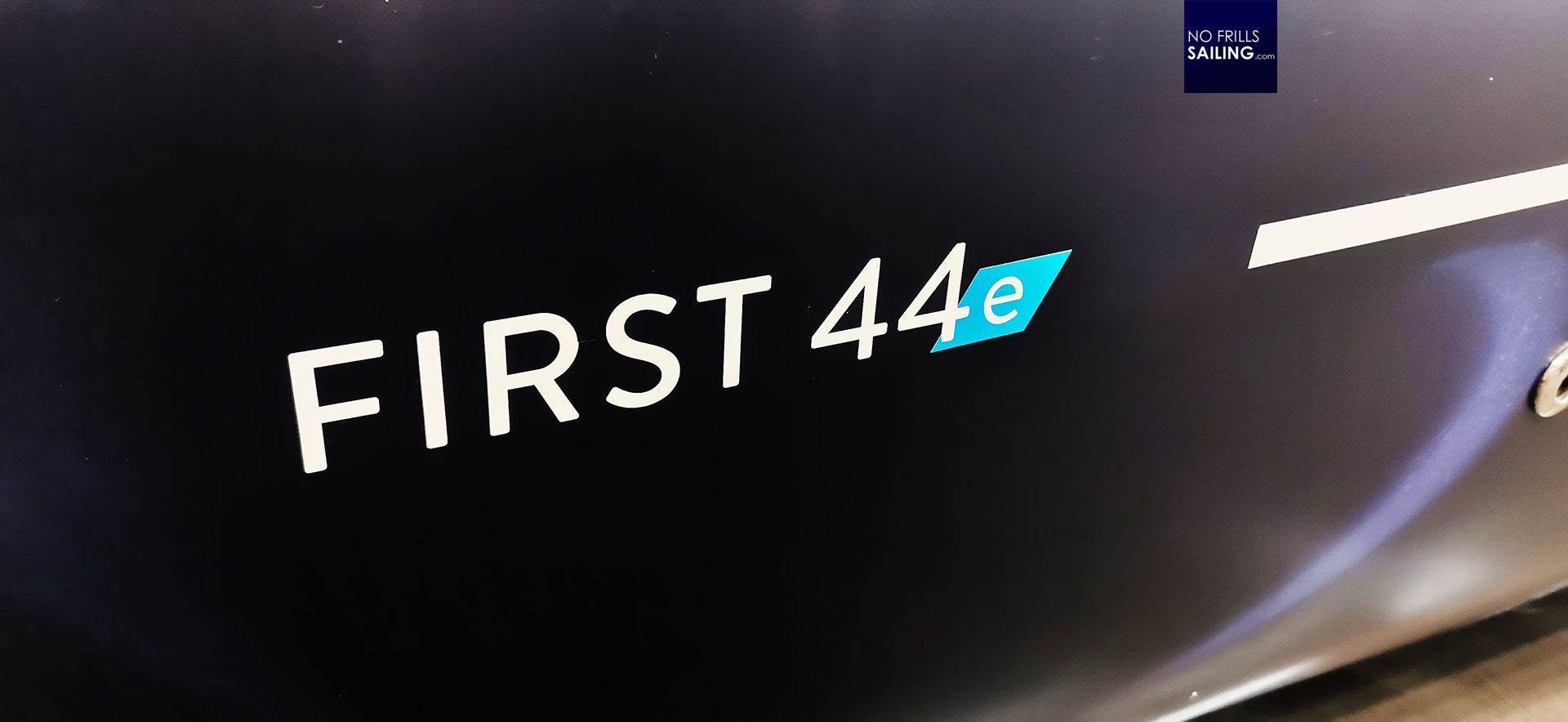
I´d call it the “Blue Revolution” because with a market leader like Groupe Beneteau so excessively investing, researching and series-producing there won´t be any other way for the other but to join. It´s comparable to what the Tesla-effect has been for the car industry. Sure, there will be dead ends along the road and many technologies have to be refined, made better. Some are not fully tested and only time will tell. But for sure, this industry will change and after seeing so many aspects of this change of course in just one company, I am convinced that many more will follow.
You might also be interested in reading these articles:
Substituting Teak in boat building: Cork as alternative?
Small start but a start nevertheless: Sustainable boatbuilding
Oceanis 30.1e – Beneteau is going full electric
